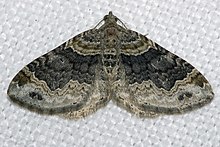Xanthorhoe ferrugata, the dark-barred twin-spot carpet, is a moth of the genus Xanthorhoe in the family Geometridae. It was first described by Carl Alexander Clerck in 1759 and has a Holarctic distribution.
| Dark-barred twin-spot carpet | |
|---|---|

| |
| Scientific classification | |
| Domain: | Eukaryota |
| Kingdom: | Animalia |
| Phylum: | Arthropoda |
| Class: | Insecta |
| Order: | Lepidoptera |
| Family: | Geometridae |
| Genus: | Xanthorhoe |
| Species: | X. ferrugata
|
| Binomial name | |
| Xanthorhoe ferrugata (Clerck, 1759)
| |
Distribution
editIt is found in Europe and east to the Russian Far East, Siberia, Tibet and China, south to the Caucasus and Turkey. Also in North America (Alaska to Newfoundland and south to North Carolina and California).
Description
editThe name-typical form of ferrugata as figured by Clerck and well described by Linne, has the median band reddish or purplish, the distal area very weakly marked (except the costal patch and two dark spots between the radials) often almost entirely white or whitish. An aberration, ab. unidentaria Haw. is a very common and very interesting aberration which has been proved, by my very extensive breeding experiments and those of Dr. Draudt, to be an almost perfect Mendelian "recessive". It differs in having the median band black, not reddish. — ab. coarctata Prout has the median band greatly narrowed, only 1–2 mm. in width; the rest of the markings often in part obsolete. - bilbainensis Fuchs, from Bilbao, said to be a local race, is described as smaller, narrower-winged, the distal edge of the median band more distinctly biangulate. I doubt its validity. — stupida Alph., from Issyk-kul, Tibet, W. Central China, etc., is rather larger, with whiter hindwing otherwise similar to ab. unidentaria.[clarification needed][1] Xanthorhoe ferrugata is difficult to certainly distinguish from Xanthorhoe spadicearia (Denis & Schiffermüller, 1775). See Townsend et al.[2] Xanthorhoe biriviata and Xanthorhoe vidanoi The larva is long and slender, naked except for a few short bristles and grey with some darker spots on the back.
Subspecies
edit- Xanthorhoe ferrugata ferrugata (Clerck, 1759)
- Xanthorhoe ferrugata fuscata (Nordström, 1935) Not recognized as a subspecies by all authors.
- Xanthorhoe ferrugata alaskae Cassino & Swett, 1925 (Alaska, Yakutat)
- Xanthorhoe ferrugata bilbainensis Fuchs, 1898 (Spain, Bilbao)
- Xanthorhoe ferrugata infumata Barnes & McDunnough, 1917 (USA, Oregon Crater Lake)
- Xanthorhoe ferrugata malaisei Djakonov, 1929 (Kamchatka, Petropavlovsk-Kamchatsky)
Biology
editThere are two generations per year in Central Europe, flying from late April to early July and from early July to mid-September. The larvae of the first generation can be observed from August to September, the second generation from June to July. The pupae of the first generation hibernate. The larvae feed on species of Galium, Stellaria, Campanula and Cirsium.
References
edit- ^ Prout, L. B. (1912–16). Geometridae. In A. Seitz (ed.) The Macrolepidoptera of the World. The Palaearctic Geometridae, 4. 479 pp. Alfred Kernen, Stuttgart.
- ^ Martin C. Townsend, Jon Clifton and Brian Goodey (2010). British and Irish Moths: An Illustrated Guide to Selected Difficult Species. (covering the use of genitalia characters and other features) Butterfly Conservation.
External links
edit